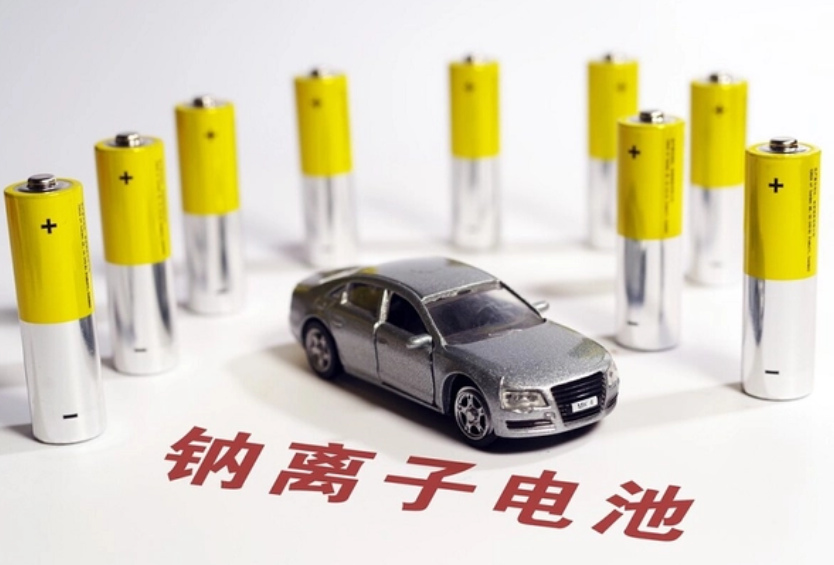Sodium-ion Battery to be Applied to the A00-Class Vehicle in 2023
Author: Lingfang Wang; Editor: Kaijun Qiu
On February 23, 2023, the first sodium-ion battery experimental vehicle “Sihao Huaxianzi,” jointly developed by Sihao New Energy and Zhongkehai Na, was unveiled.
According to industry insiders, in the fourth quarter of 2023, BYD’s sodium-ion battery will be installed on the A00-class vehicle Haiou, with an expected retail price of 60,000 yuan and a range of 300 km.
Ningde Times’ sodium-ion battery will also be applied to the A00-class vehicle in 2023, and the first model will be the SAIC Keweiwei facelift. The technology used will be layered and hard carbon.
All these messages tell us that mass production and installation of sodium-ion batteries are just around the corner.
Can sodium-ion batteries be used so quickly? On February 24-25, 2023, at the China New Energy Battery Industry Peak Summit, many guests also expressed their views on sodium-ion batteries, reaching a consensus on the technological progress, R&D, production difficulties, and application areas of sodium-ion batteries.
Lithium-ion Battery Enterprises Lay Out Sodium-ion Batteries One after Another
Generally speaking, sodium-ion batteries are divided into three technical routes: layered oxide, Prussian blue (white), and poly anion.
The advantage of layered oxide is high specific capacity and high voltage platform, while its disadvantages are poor structural stability and cycling stability, as well as the tendency to generate gas.
The advantage of Prussian blue (white) route is high specific capacity, but the difficulty of removing crystallization water affects the thermal stability and cycling performance of the positive electrode material.
The advantage of poly anion is high voltage platform, good structural stability, thermal stability, and cycling stability, while its disadvantages are low specific capacity and poor conductivity.
At present, major lithium-ion battery manufacturers in China are laying out sodium-ion batteries.
“Honeycomb Energy chose two routes, layered oxide and poly anion,” said Gao Fei, deputy director of the Honeycomb Energy Technology Center, at the summit.
According to the plan, Honeycomb Energy hopes to achieve an energy density of 135 Wh/kg for sodium-ion batteries by 2023, 160 Wh/kg by 2024-2025, and finally 180-200 Wh/kg.“`
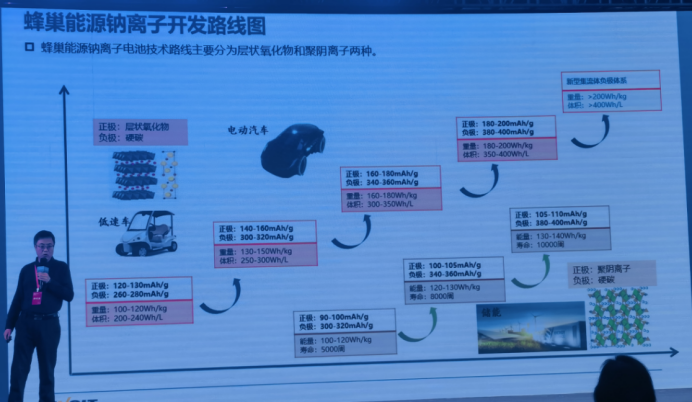
Gaofei believes that the low-temperature performance of sodium-ion batteries is very good. Currently, the sodium-ion batteries developed by Honeycomb Energy Co., Ltd. can maintain a capacity retention rate of 97% at -20°C with 3C discharge.
The sodium-ion battery, which adopts a layered oxide positive electrode, hard carbon negative electrode, carbonate ester electrolyte, and commercial polymer separator, can still maintain a cycle of 97% after 600 cycles of 1C charge and discharge at 25°C; after 450 cycles of 1C charge and discharge at 45°C, the capacity retention rate is over 94%.
In addition, in terms of safety, the safety of sodium-ion batteries is significantly better than that of lithium-ion batteries. It does not explode, catch fire or emit smoke even in a 200 °C hot box and with needle penetration.
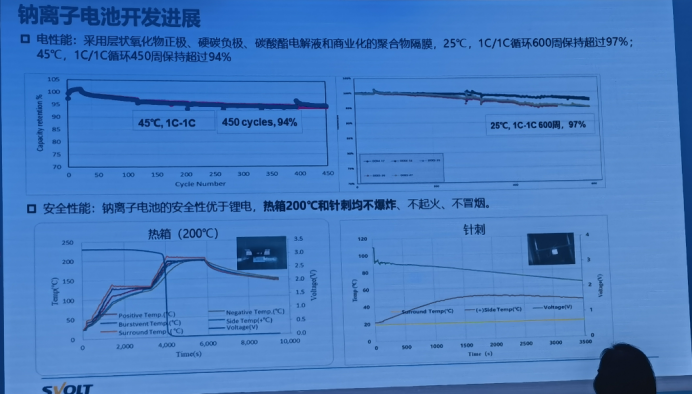
Obviously, the progress of Honeycomb Energy’s sodium-ion battery is not the fastest.
Last year, EVE Energy Co., Ltd. also released the first generation of large cylindrical sodium-ion battery products, with an energy density of 135 Wh/kg and a cycle life of up to 2,500 times. The product is preparing to enter the pilot test phase.
In December last year, Xinwanda stated on the investor interactive platform that the company’s sodium-ion battery samples were undergoing testing and verification, and the project progress was smooth. The specific listing plan will be determined according to customer needs.
In terms of technical progress, Ningde Times appears to be the fastest. When it released the first generation of sodium-ion batteries in July 2021, the energy density of the single cell had reached 160Wh/kg. The second generation of sodium-ion batteries will have an energy density of up to 200Wh/kg, which is close to that of ternary lithium batteries.
It is expected to enter the expansion stage in 2024
Theoretically, sodium-ion batteries, which are cheaper, are not cheap at this stage.
In the view of Wang Zidong, Deputy Secretary-General of the China Automotive Power Battery Industry Innovation Alliance, at least for now, the cost of sodium-ion batteries will definitely not be lower than that of lithium-ion batteries, which is not a technical problem but a lack of an industrial chain problem.
Wang Zidong gave a figure that the current cost of the negative electrode of sodium-ion batteries is 3-5 times the price of domestic ternary positive electrode materials. The reason for this is that most of the hard carbon used as the negative electrode of sodium-ion batteries still needs to be imported.
“`In September 2022, the price of Japanese coconut shell hard carbon is about 200,000 yuan/ton, and the price of low-end artificial graphite negative electrode is about 30,000 yuan/ton.
The precursor raw materials mainly used for hard carbon are biomass, resin and polymer precursors. Coconut shell biomass material is one of the earliest commercialized hard carbon precursors. This type of material is widely distributed in nature, has fewer impurities, and has a high strength, which can provide stable structure for the hard carbon product.
However, currently, the domestic supply of coconut shell raw materials for producing hard carbon negative electrodes is insufficient and it needs to rely on imports. The domestic production capacity of hard carbon negative electrodes is limited, only a few thousand tons.
According to Dongwu Securities, the cost of sodium-ion batteries in the promotion period is about 0.8-0.9 yuan/Wh, which has no cost-performance advantage compared with lithium iron phosphate batteries.

Without an industry chain, it can only be at the mercy of others.
However, with the improvement of the industry chain, economies of scale being realized, and entering the development and maturity stages, the cost of sodium-ion batteries is expected to drop to 0.5 yuan/Wh, while the total cost of lithium iron phosphate batteries is approximately 0.7 yuan/Wh (the price of lithium carbonate is assumed to be 150,000 yuan/ton), which is more than 20% cheaper. In terms of the cost of cell materials, the cost of sodium-ion batteries is expected to be 0.1 yuan/Wh lower than that of lithium iron phosphate batteries, which is more than 25% cheaper.
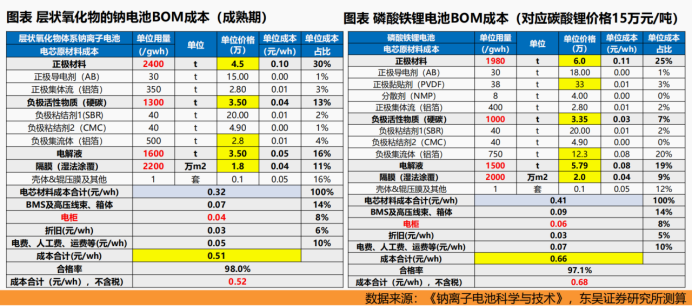
Except for leading companies such as CATL and BYD, most industrial chain companies are still in the pilot stage.
In January of this year, Do-Fluoride stated in response to investor questions that the trial production line for the positive electrode material of the sodium-ion battery has been built, and batch products have been offline and are undergoing various tests and customer vehicle testing. Xungoal shares also stated that the construction of the sodium-ion battery pilot production line is progressing in an orderly manner and is planned to be put into operation in 2023. At the same time, the construction of the first-phase production line can also be started.
CATL is a leading company in sodium-ion batteries. In November last year, CATL also stated that the sodium-ion battery pilot production line has been put into operation, and the relevant technical parameters of the produced sodium-ion battery products are: the energy density of a single unit is 150Wh/kg-160Wh/kg, and the cycle times are not less than 4000 times.Regarding the development of hard carbon anode, some companies have achieved industrialization. In December last year, Bettery announced in an investor Q&A that the company has the capacity for the industrialization of hard carbon anode and is building a hard carbon production line. Meanwhile, the sodium battery anode has been certified by some domestic customers for orders of tons or more, and the company is continuously supplying and actively introducing into other leading companies to enhance production capacity planning.
At the same period, Xiangfenghua revealed in an investor Q&A that their high-performance hard carbon anode materials are currently being tested by related customers.
Industry insiders predict that various technology samples and scaled products will enter the market in 2023, and with engineering practice and downstream bulk certifications, the industry scale expansion period of 1-10 is expected to be reached by 2024.
Technical Difficulties: High gas production and poor cycling performance
To achieve industrialization for sodium-ion batteries, many technical problems need to be overcome.
Kong Dongbo, the Vice General Manager of Hunan Far East New Energy Technology Co., Ltd. introduced that the ionic radius of sodium-ion is much larger than that of lithium-ion, making it difficult to de-intercalate and causing a very slow dynamic characteristics, a large volume change of electrode materials, and poor cycling performance. Thus, all components of the entire system, including electrode materials and separators, need to be developed, and previous approaches for lithium-ion batteries cannot be fully used.
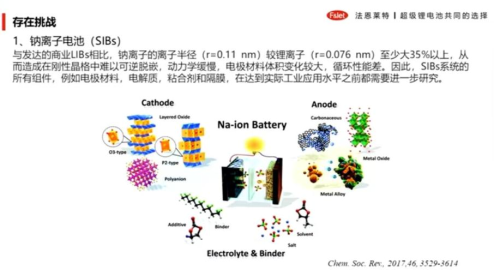
Specifically, the positive electrode material for sodium-ion batteries has not yet achieved large-scale stable production and its structural stability needs to be improved, and the gas production issue is also severe during the cycling process.
Kong Dongbo explained that the main problem that needs to be solved for sodium-ion batteries is the gas production during the formation process, as well as during the later charging and long-term storage.
He believes that there are several reasons for this, including the reduction of water in the electrolyte, the electrochemical reduction of solvent molecules on the negative electrode, and the negative reaction of the negative electrode reduction products and solvent molecules under a charged state. The solution is to develop new types of solvents that dissolve residual alkali and introduce additives that suppress gas production.
 The negative electrode of sodium-ion batteries can currently only choose hard carbon, but the Coulomb efficiency is relatively low (the ratio of the discharge capacity of the battery to the charging capacity during the same cycle), and the price is high.
The negative electrode of sodium-ion batteries can currently only choose hard carbon, but the Coulomb efficiency is relatively low (the ratio of the discharge capacity of the battery to the charging capacity during the same cycle), and the price is high.
In Kong Dongbo’s view, the negative electrode is currently a big problem. Simply put, graphite is difficult to store sodium and cannot be used as the negative electrode material for sodium-ion batteries. Hard carbon is currently the only negative electrode material for sodium-ion batteries.
The atomic radius of sodium ions is at least 35% larger than that of lithium ions, and it is difficult for sodium ions to insert and extract from materials, which puts higher requirements on the structural stability of negative electrode materials.
The pore size and interlayer distance of graphite negative electrode materials used in lithium-ion batteries cannot meet the requirements of sodium-ion battery negative electrodes. The interlayer distance of hard carbon is much larger than that of graphite.

In addition, the electrolyte is still being explored. In the past, ether-based electrolytes have rarely been used as electrolytes because their passivation ability on the negative electrode is poor and unstable at working voltages above 4V.
However, in recent years, ether-based electrolytes have been widely used in the field of sodium-ion batteries because they have better antioxidant and reduction capabilities in the sodium-electrolyte system, and they can generate thinner and more stable SEI films and higher first Coulomb efficiency on the negative electrode surface compared to ester-based electrolytes.
However, when the voltage of the sodium-ion battery exceeds 4V, it is necessary to improve the cycle performance under high voltage. Ether-based electrolytes cannot meet this requirement and require the introduction of fluorinated ether solvents and high-voltage additives.

Kong Dongbo said that their research and development of sodium-ion batteries is divided into three stages. The short-term goal is to improve the solution for severe gas production during high-temperature cycling of the battery and effectively improve the gas production situation. The medium-term goal is to choose suitable electrolytes to make the cycling of 4.2V high-voltage sodium-ion batteries exceed 500 cycles, with a capacity retention rate of over 85%. The long-term goal is to develop a new solvent system to adapt to batteries in different working environments, enhance cycling performance, and achieve a capacity retention rate of over 85% for normal temperature cycling of 1500 weeks, high-temperature cycling of 800 weeks, and low-temperature cycling of 800 weeks.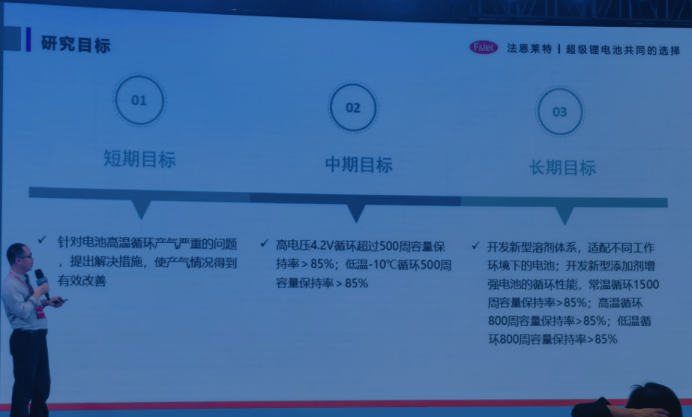
Application: Energy Storage and Low-Range Vehicles
The advantage of sodium-ion batteries lies in their low cost and good performance. However, the core problem is that the energy density per unit volume is too low, and too few batteries can be installed in a limited volume, which restricts the application scope of sodium-ion batteries.
At the meeting, the experts unanimously agreed that the recognized application areas are energy storage, low-speed vehicles, and A00-class vehicles. In other words, sodium-ion batteries cannot replace lithium-ion batteries and can only serve as a supplement to them.
Kong Dongbo believes that energy storage is the most suitable scenario for sodium-ion batteries, and the core reason is that large-scale energy storage systems have low requirements for battery energy density and higher requirements for safety and economics.
According to the cost calculation given by Kong Dongbo, compared with lead-acid batteries, lithium iron phosphate batteries, and ternary batteries used for energy storage, sodium-ion batteries are the lowest in terms of degree electric cost calculated with and without electricity loss and with a discount rate of 0.
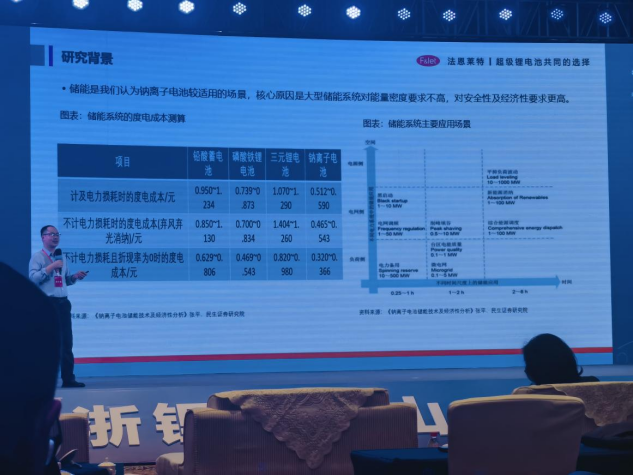
Gao Fei believes that the core direction of sodium-ion batteries should be energy storage and lightweight power. Unlike Kong Dongbo, Gao Fei focused on the application of sodium-ion in the field of lightweight power. A typical example is the transportation field. Gao Fei believes that the main application scenarios of sodium-ion batteries are two-wheeled vehicles, low-speed vehicles, and A00-class vehicles, which are tools for travels within approximately 300 kilometers.
This article is a translation by ChatGPT of a Chinese report from 42HOW. If you have any questions about it, please email bd@42how.com.
